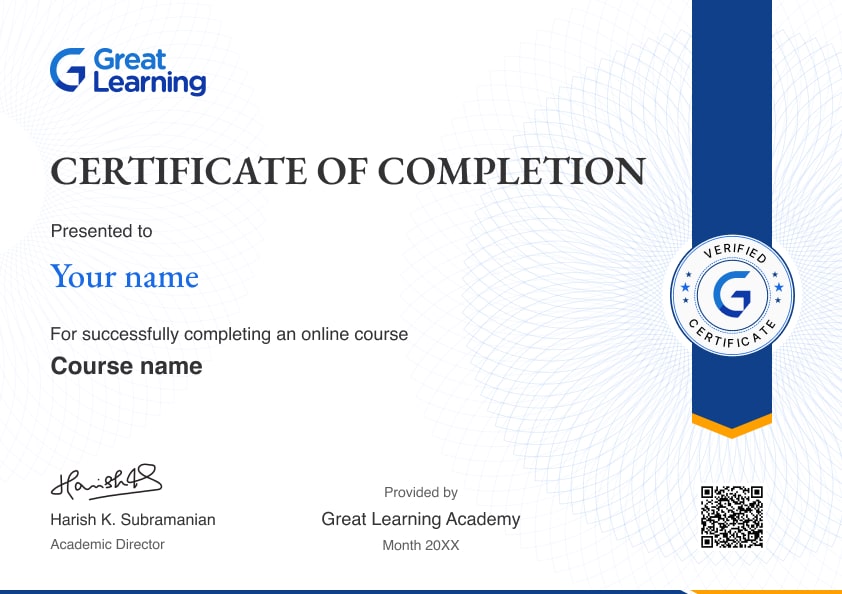Earn a certificate & get recognized
Introduction to Value Investing
Enrol now and equip yourself with the knowledge and strategies to make wise investment decisions. Join us today and take the first step towards a brighter financial future!
Introduction to Value Investing
1.2K+ learners enrolled so far
Stand out with an industry-recognized certificate
10,000+ certificates claimed, get yours today!
Get noticed by top recruiters
Share on professional channels
Globally recognised
Land your dream job

Skills you will gain
Risk and Return
Asset Allocation
Return On Investments
Saving and Investing
Wealth Accumulation
Technical vs. Fundamental Analysis
Financial Statements
Cash Flow Statement
Different Types of Value
+4 More
Key Highlights
Get free course content
Master in-demand skills & tools
Test your skills with quizzes
About this course
Get started on your value investing journey with our free course. From understanding the basics of investing and financial concepts to diving into the core principles and philosophies of value investing, you'll gain the knowledge and insights needed for successful long-term investing. The course also includes real-life case studies to help you apply your newfound expertise in the world of value investing, making it an ideal choice for those looking to build their investment skills.
Course outline
Introduction to Investing
Gain a foundational understanding of investment principles.
Understanding the Basic Financial Concepts
Gain a foundational understanding of essential financial concepts.
Introduction to Value Investing
Explore the core principles and strategies of value investing.
Key Philosophies of Value Investing
Dive into the fundamental philosophies that drive value investors.
Case Studies on Value Investment
Analyze real-world cases to apply value investing strategies effectively.
Get access to the complete curriculum once you enroll in the course
Stand out with an industry-recognized certificate
10,000+ certificates claimed, get yours today!
Get noticed by top recruiters
Share on professional channels
Globally recognised
Land your dream job

Introduction to Value Investing

1.5 Hours
Beginner
1.2K+ learners enrolled so far
Get free course content
Master in-demand skills & tools
Test your skills with quizzes
Learner reviews of the Free Courses

4.0
What our learners enjoyed the most
Skill & tools
62% of learners found all the desired skills & tools
Frequently Asked Questions
Will I receive a certificate upon completing this free course?
Is this course free?
What is Value Investing?
Value investing is an investment strategy that involves identifying undervalued stocks and assets in the market. It's based on the idea of buying assets at a lower price than their intrinsic value.
Who is this course suitable for?
This course is suitable for anyone interested in learning the fundamentals of value investing, whether you're a beginner or have some experience in investing.
Is this course really free?
Yes, this course is completely free. We believe in making valuable knowledge accessible to everyone.
Do I need any prior knowledge of finance or investing?
No prior knowledge is required. This course is designed to be beginner-friendly, and we'll start from the basics.
Will I receive a certificate upon completion?
Yes, upon successful completion of the course and any required assessments, you will receive a certificate to showcase your knowledge of value investing.
How do I enroll in the course?
To enrol, simply click the "Enrol for free" button on the course page.
Become a Skilled Professional with Pro Courses
Gain work-ready skills with guided projects, top faculty and AI tools, all at an affordable price.

View Course

Included with Pro+ Subscription


View Course

Included with Pro+ Subscription
.jpg)
View Course

Included with Pro+ Subscription


View Course

Included with Pro+ Subscription

View Course

Included with Pro+ Subscription

View Course

Included with Pro+ Subscription
 (1).jpg)
View Course

Included with Pro+ Subscription

View Course

Included with Pro+ Subscription


View Course

Included with Pro+ Subscription


View Course

Included with Pro+ Subscription


View Course

Included with Pro+ Subscription


View Course

Included with Pro+ Subscription


View Course

Included with Pro+ Subscription


.png)
View Course

Included with Pro+ Subscription

View Course

Included with Pro+ Subscription

View Course

Included with Pro+ Subscription

View Course

Included with Pro+ Subscription

View Course

Included with Pro+ Subscription
.png)
View Course

Included with Pro+ Subscription
.png)
View Course

Included with Pro+ Subscription

View Course

Included with Pro+ Subscription
.png)
View Course

Included with Pro+ Subscription
.jpg)
View Course

Included with Pro+ Subscription

View Course

Included with Pro+ Subscription

View Course

Included with Pro+ Subscription
.png)
View Course

Included with Pro+ Subscription

View Course

Included with Pro+ Subscription

View Course

Included with Pro+ Subscription

View Course

Included with Pro+ Subscription

View Course

Included with Pro+ Subscription


View Course

Included with Pro+ Subscription
.png)
View Course

Included with Pro+ Subscription

View Course

Included with Pro+ Subscription

View Course

Included with Pro+ Subscription
.png)
View Course

Included with Pro+ Subscription
.png)
View Course

Included with Pro+ Subscription


View Course

Included with Pro+ Subscription



View Course

Included with Pro+ Subscription

View Course

Included with Pro+ Subscription
.jpg)
View Course

Included with Pro+ Subscription

View Course

Included with Pro+ Subscription

View Course

Included with Pro+ Subscription



.png)
View Course

Included with Pro+ Subscription


View Course

Included with Pro+ Subscription


View Course

Included with Pro+ Subscription


View Course

Included with Pro+ Subscription
.png)


View Course

Included with Pro+ Subscription


View Course

Included with Pro+ Subscription

View Course

Included with Pro+ Subscription

View Course

Included with Pro+ Subscription

View Course

Included with Pro+ Subscription


View Course

Included with Pro+ Subscription
.png)
View Course

Included with Pro+ Subscription

View Course

Included with Pro+ Subscription
Popular

View Course

Included with Pro+ Subscription


View Course

Included with Pro+ Subscription
.jpg)
View Course

Included with Pro+ Subscription


View Course

Included with Pro+ Subscription

View Course

Included with Pro+ Subscription

View Course

Included with Pro+ Subscription
 (1).jpg)
View Course

Included with Pro+ Subscription

View Course

Included with Pro+ Subscription
Microsoft Courses


View Course

Included with Pro+ Subscription


View Course

Included with Pro+ Subscription


View Course

Included with Pro+ Subscription


View Course

Included with Pro+ Subscription


View Course

Included with Pro+ Subscription


Management
.png)
View Course

Included with Pro+ Subscription

View Course

Included with Pro+ Subscription

View Course

Included with Pro+ Subscription

View Course

Included with Pro+ Subscription

View Course

Included with Pro+ Subscription
.png)
View Course

Included with Pro+ Subscription
.png)
View Course

Included with Pro+ Subscription

View Course

Included with Pro+ Subscription
.png)
View Course

Included with Pro+ Subscription
.png)
View Course

Included with Pro+ Subscription
.jpg)
View Course

Included with Pro+ Subscription
.jpg)
View Course

Included with Pro+ Subscription
.jpeg)
View Course

Included with Pro+ Subscription
.jpg)
View Course

Included with Pro+ Subscription
.png)
View Course

Included with Pro+ Subscription
 (1).jpg)
View Course

Included with Pro+ Subscription
IT & Software
.jpg)
View Course

Included with Pro+ Subscription

View Course

Included with Pro+ Subscription

View Course

Included with Pro+ Subscription
.png)
View Course

Included with Pro+ Subscription

View Course

Included with Pro+ Subscription

View Course

Included with Pro+ Subscription

View Course

Included with Pro+ Subscription

View Course

Included with Pro+ Subscription


View Course

Included with Pro+ Subscription
 (1).png)
View Course

Included with Pro+ Subscription


View Course

Included with Pro+ Subscription

View Course

Included with Pro+ Subscription


View Course

Included with Pro+ Subscription

View Course

Included with Pro+ Subscription
.png)
View Course

Included with Pro+ Subscription
.png)
View Course

Included with Pro+ Subscription

View Course

Included with Pro+ Subscription

View Course

Included with Pro+ Subscription

View Course

Included with Pro+ Subscription

View Course

Included with Pro+ Subscription

View Course

Included with Pro+ Subscription
Cyber Security
.png)
View Course

Included with Pro+ Subscription

View Course

Included with Pro+ Subscription

View Course

Included with Pro+ Subscription
.png)
View Course

Included with Pro+ Subscription
.png)
View Course

Included with Pro+ Subscription
AI & Generative AI


View Course

Included with Pro+ Subscription



View Course

Included with Pro+ Subscription

View Course

Included with Pro+ Subscription
.jpg)
View Course

Included with Pro+ Subscription

View Course

Included with Pro+ Subscription

View Course

Included with Pro+ Subscription
Cloud Computing



.png)
View Course

Included with Pro+ Subscription


View Course

Included with Pro+ Subscription


View Course

Included with Pro+ Subscription


View Course

Included with Pro+ Subscription
.png)


View Course

Included with Pro+ Subscription


View Course

Included with Pro+ Subscription
.png)

View Course

Included with Pro+ Subscription
.jpg)

.jpg)

.png)

View Course

Included with Pro+ Subscription


Data Science & ML

View Course

Included with Pro+ Subscription

View Course

Included with Pro+ Subscription

View Course

Included with Pro+ Subscription


View Course

Included with Pro+ Subscription
.png)
View Course

Included with Pro+ Subscription

View Course

Included with Pro+ Subscription
Subscribe to Academy Pro+ & get exclusive features
$25/month
No credit card required

Learn from 40+ Pro courses

Access 500+ certificates for free

700+ Practice exercises & guided projects

Prep with AI mock interviews & resume builder
Recommended Free Management courses



Similar courses you might like

.jpg)


Related Management Courses
-
Programs starting at ₹5,000 per month
Placement assistance
Personalized mentorship
Detailed curriculum
Learn from world-class faculties
50% Average salary hike -
Sponsored


Great Lakes Institute of Management
Post Graduate Diploma in Management (Online)24 Months · Online
Online MBA EquivalentKnow More
-


Walsh College
Doctor of Business Administration in General Management3 Years · Online
Top 10 best online DBA DegreeKnow More
-


Great Lakes Executive Learning
Executive PG Program in Management12 months · Online
Certificate from Great LakesKnow More
Relevant Career Paths >
Introduction to Value Investing
Value investing is a renowned investment philosophy that has been practiced by some of the most successful investors in history, including Warren Buffett, Benjamin Graham, and Charlie Munger. It revolves around the idea of identifying and investing in assets that are believed to be undervalued by the market, with the expectation that their true worth will eventually be recognized, leading to significant long-term gains. In this introduction to value investing, we will delve into the core principles, strategies, and key concepts that form the foundation of this investment approach.
Core Principles of Value Investing
Intrinsic Value
At the core of value investing lies the concept of intrinsic value. Intrinsic value represents the true worth of an asset or investment. Value investors believe that market prices can often be irrational and deviate from an asset's intrinsic value. The primary goal is to find assets that are trading below their intrinsic value, indicating a potential bargain.
Margin of Safety
Benjamin Graham, considered the father of value investing, introduced the concept of the "margin of safety." This concept entails investing in assets with a significant discount to their intrinsic value to protect against unforeseen risks and errors in judgment. A margin of safety provides a cushion for potential losses and enhances the resilience of an investment strategy.
Long-Term Perspective
Value investors adopt a long-term perspective. They are not overly concerned with short-term market fluctuations or trends. Instead, they believe that, over time, the market will recognize the true value of their investments, leading to favorable returns.
Strategies and Methods of Value Investing
Fundamental Analysis
Value investors perform thorough fundamental analysis of a company, dissecting its financial statements, business model, competitive position, and management team. They scrutinize stocks with strong fundamentals, emphasizing a history of stable or growing earnings.
Price-to-Earnings (P/E) Ratio
Among the most commonly used metrics in value investing is the P/E ratio. This ratio compares the current stock price to the company's earnings per share (EPS). A lower P/E ratio suggests that a stock may be undervalued, as investors are paying less for each dollar of earnings, making it an attractive investment candidate.
Dividend Yield
Value investors often seek stocks with an attractive dividend yield. A high dividend yield may indicate that a company is distributing profits to shareholders, reflecting financial stability and enhancing the appeal of the stock.
Book Value
Book value, the total assets minus total liabilities of a company, is another metric value investors consider. They may look for stocks trading below their book value, viewing such stocks as potential bargains.
Asset-Based Investing
Some value investors focus on the underlying assets of a company, which can include real estate, patents, cash, and more, to determine if a stock is undervalued based on the assessed value of these assets.
Key Concepts in Value Investing
Contrarian Investing
Value investors often embrace contrarian thinking. When the majority of investors are selling, value investors may perceive an opportunity to buy undervalued assets. This willingness to go against market sentiment is a fundamental aspect of value investing.
Quality Over Quantity
Value investors prioritize the quality of their investments over quantity. They prefer holding a concentrated portfolio of well-researched assets rather than a diversified but less-researched one. This focused approach allows for more in-depth analysis and management of investments.
Economic Moats
Warren Buffett popularized the concept of an economic moat. An economic moat refers to a company's competitive advantage, which can result from factors such as strong brands, cost advantages, network effects, or other barriers that make it difficult for competitors to challenge the business.
Patience and Discipline
Successful value investing demands patience and discipline. It may take time for the market to recognize the true value of an asset, and value investors are willing to hold their investments for years, if not decades. Maintaining discipline in adhering to a well-researched strategy is a key component of success.
Continuous Learning
Value investing is not a static approach. It necessitates continuous learning and adaptation to changing market conditions and economic landscapes. Investors must stay informed and adjust their strategies as needed to remain effective in their investments.
In conclusion, value investing is a time-tested investment approach based on the principles of intrinsic value, margin of safety, and a long-term perspective. It has been validated by some of the world's most renowned investors, but it is not a guaranteed path to riches. This investment strategy involves risks, requires thorough research and analysis, and often necessitates patience for the market to recognize the true value of investments. It is vital to do your own research, understand your risk tolerance, and consider seeking advice from financial professionals before making investment decisions.












